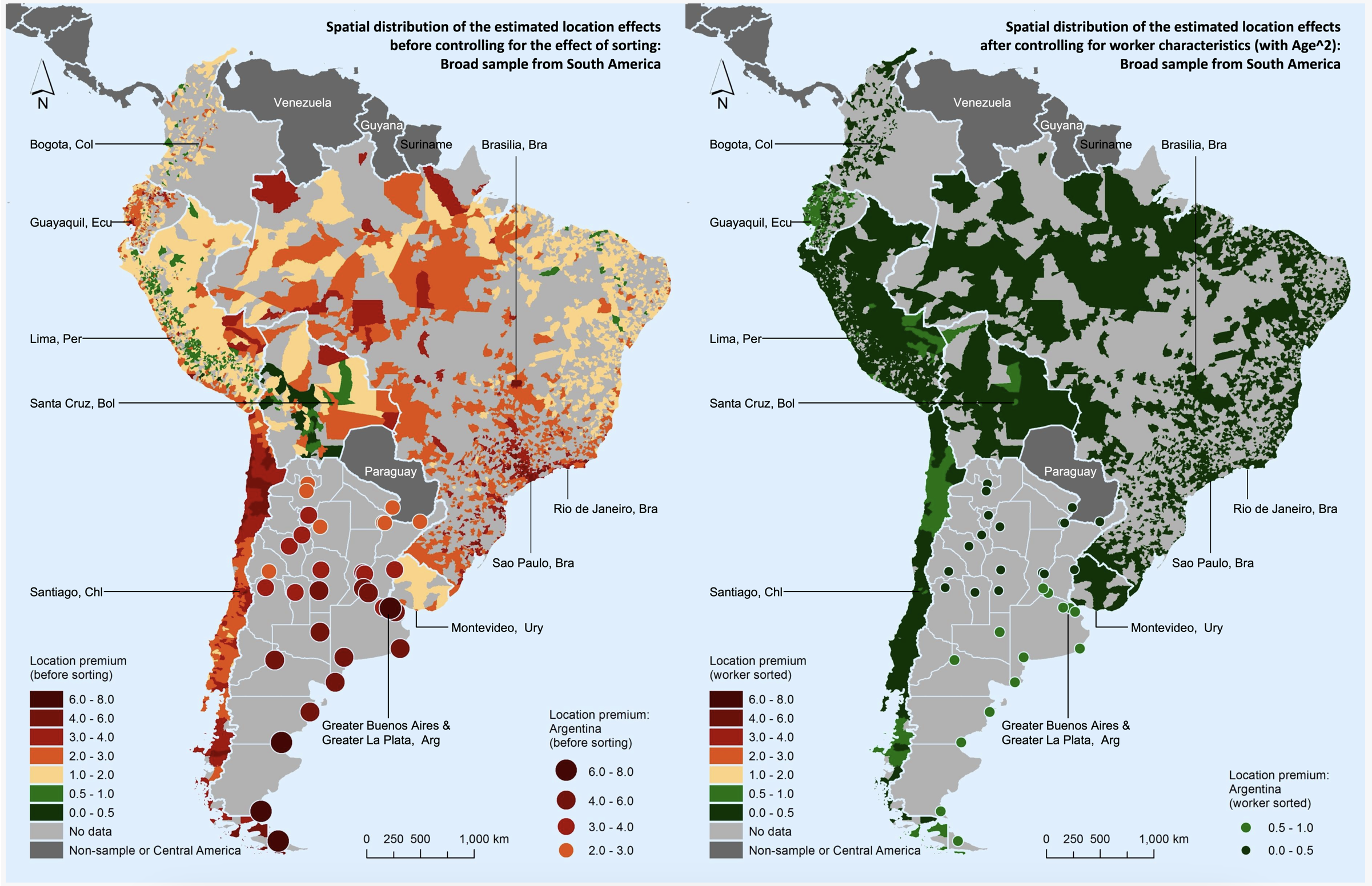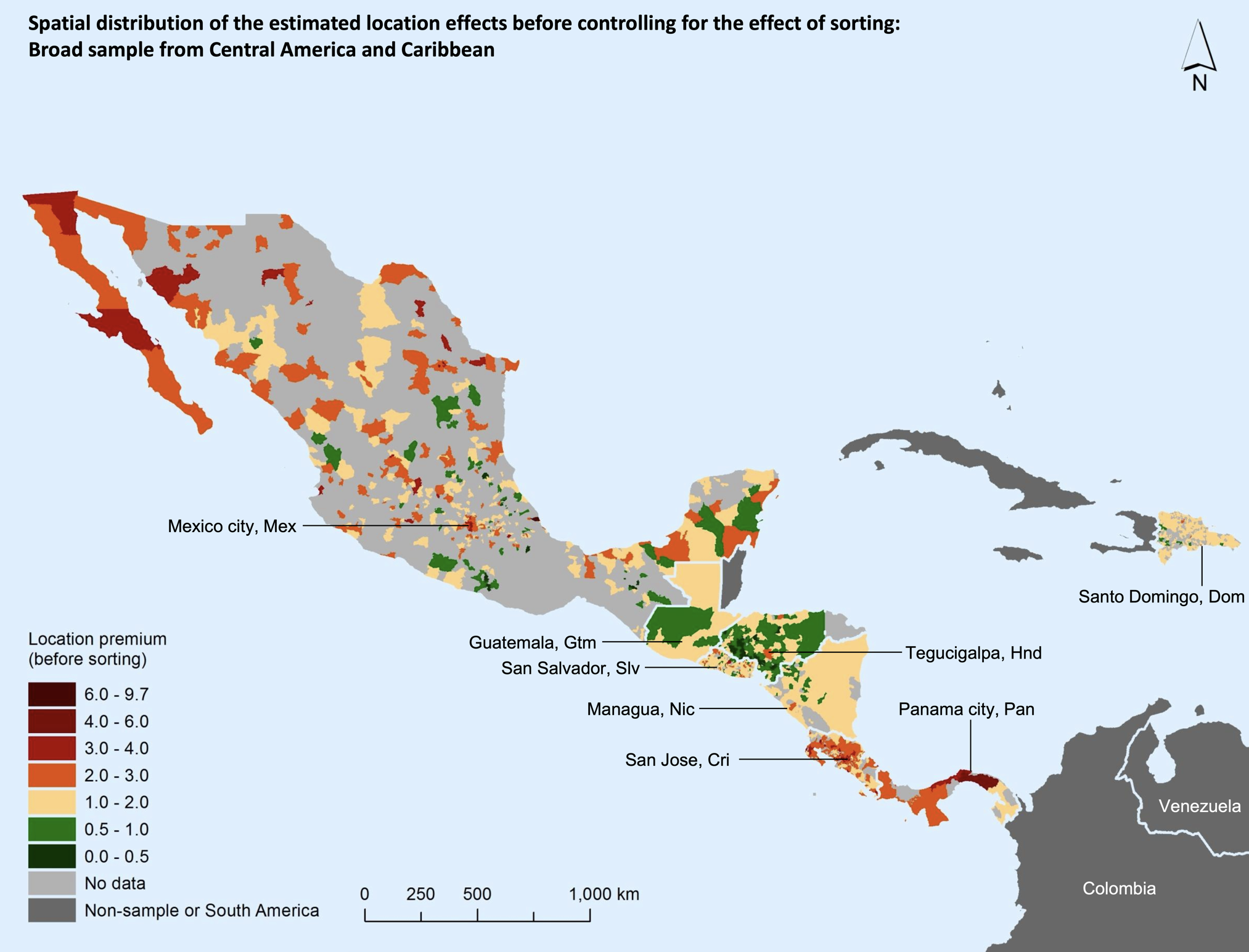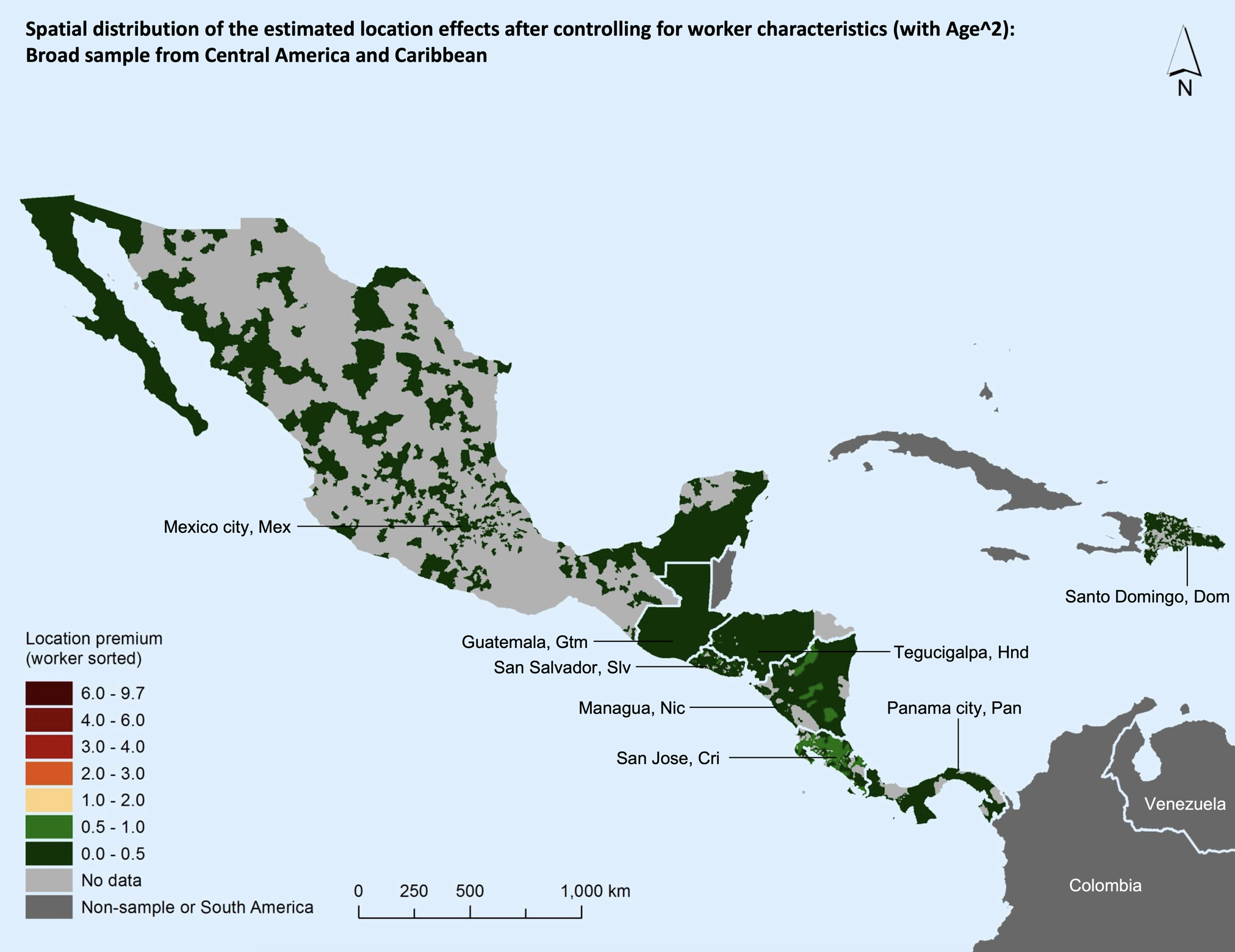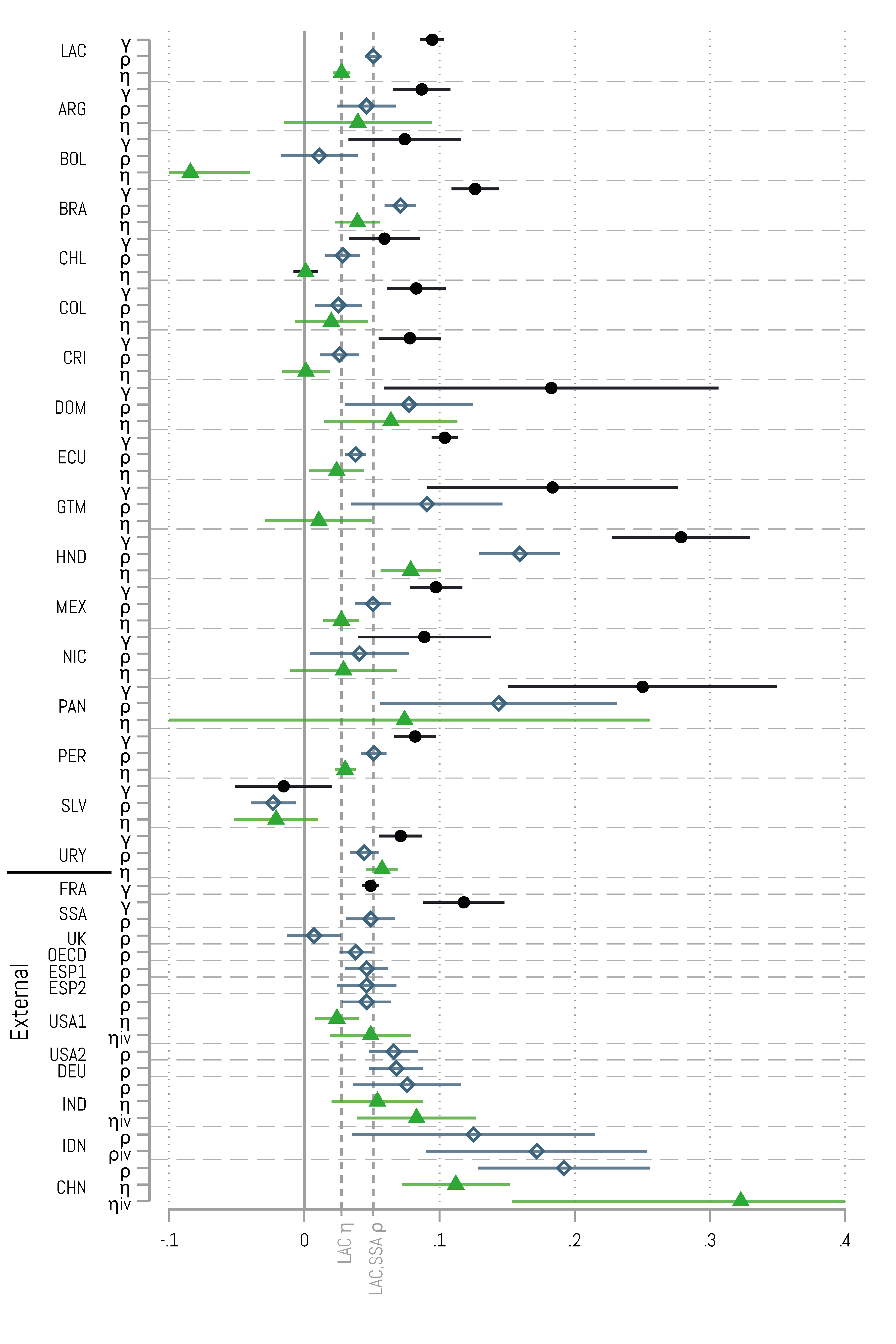The slowdown in productivity growth documented for the Latin America and the Caribbean (LAC) region since the 2010s, following the global collapse of commodity prices in mid-2008 that exposed its dependence on commodity exports, has led to growth underperformance in the region. This has raised concerns among policymakers about how to boost productivity. The issue made headlines in The Economist in an article that garnered controversy because many perceived it as unfairly criticising Latin American workers. Yet, this concern had already been introduced to policy discussions, with much more nuance, in a comprehensive report by the UNDP in 2021. The report documents that the productivity growth slowdown has been accompanied by a large spatial disparity in productivity between leading and lagging regions. While this has been a concern worldwide (see for example the contributions to the Vox debate on the causes and consequences of spatial disparities), the LAC region is particularly characterised by high overall inequality and significant disparities in income across its regions (Eslava and Valencia 2023).
Two hypotheses for geographic differences in economic development
A hallmark of economic development is its geographically uneven nature, often underpinned by productivity differences between a country’s leading and lagging areas (World Bank 2009). Mobility is costly (Bosquet and Overman 2016), so initial differences in city productivity can persist over many decades, leading to sustained differences in living standards. Understanding these productivity disparities is a subject of intense empirical research. The two most studied explanations for productivity disparities between cities within a country are agglomeration economies – citywide productivity benefits associated with urban density and scale (Duranton and Puga 2004) – and human capital externalities, which refer to productivity-boosting knowledge spillovers resulting from a highly skilled workforce (Moretti 2004, Dingel et al. 2021). Density can facilitate both matching between workers and firms (Dauth et al. 2019) and the emergence of a wide array of local suppliers of intermediate inputs, while an educated workforce can create spillovers for everyone. The empirical exploration of these factors has, with few exceptions, primarily focused on high-income countries (Duranton 2015, Ahlfeldt and Pietrostefani 2019).
The study
In our recent study (Quintero and Roberts 2023), we assessed the role of agglomeration economies and human capital externalities in 16 LAC countries.
This assessment utilised household survey data that has been carefully harmonised by the Center for Distributive, Labor, and Social Studies (CEDLAS) and the World Bank for over 6.4 million workers. Following common practice (Combes et al. 2008, De la Roca and Puga 2017), we used a worker’s nominal wage as a proxy for his or her productivity.
In our analysis, we considered workers' reported characteristics, such as age, gender, and education, to account for ‘sorting’ – that is, the tendency for more productive workers to gravitate towards denser and/or more highly educated cities. We then explored the remaining variation in their productivity – the portion not explained by the traits of individual workers but by city characteristics. Our focus was on a city’s density and its average stock of human capital to quantify the impacts of agglomeration economies and human capital externalities. Through various specifications, we delved into how physical geography, worker characteristics, and a city’s human capital stock relate to the connection between productivity and density.
Initially, we observed large disparities in average nominal wages across sub-national regions. The highest levels of nominal wages, and thus productivity, are found in major cities like Bogota, Buenos Aires, Lima, Mexico City, Panama City, Santa Cruz, Santiago, and Sao Paulo. However, the city premium – the estimated productivity ‘bonus’ that remains after controlling for worker characteristics – varies by 80% less than the nominal wage (compare left and right panels of Figures 1 and the top and bottom panels of Figure 2). This indicates that much of the disparity in productivity across cities relates more to differences in workers than to the city environment itself, a result consistent with recent analysis between regions in Italy that suggests that city characteristics do not explain a large proportion of productivity disparities (Briskar et al. 2023).
Figure 1
Note: The left panel shows the nominal wage average by city. The right panel shows the city premium, which is the estimated productivity net of worker characteristics. After controlling for these worker characteristics, productivity differences across cities become smaller.
Figure 2
Note: The top panel shows the nominal wage average by city. The bottom panel shows the city premium, which is the estimated productivity net of worker characteristics. After controlling for these worker characteristics, productivity differences across cities become smaller.
This doesn't, however, provide a complete picture. Cities do play a role in influencing the productivity of their workers. We still observe a difference of more than $5 per hour between cities with the largest and the smallest city premia within a country. This variation is what we aim to explain, initially through a city’s density and later by considering both its density and human capital stock.
Elasticity of productivity with respect to density
First, we estimated the elasticity of productivity with respect to density to capture the overall benefits of agglomeration, controlling for both worker characteristics and a city’s physical geography. Overall, the average of these estimates from other studies for developed countries (like the UK, the OECD, Spain, the US, and Germany) is lower (4.53%) than for developing countries (7.73%). For developed nations, most estimates hover around 5%, which emerges as a benchmark. This is also close to estimates for Central Asia and Eastern European countries by the European Bank of Reconstruction and Development (Desmet et al. 2019). The variation across developing regions is more pronounced. Estimates for Asian countries average 7.73%. We estimate an elasticity that is close to 5% when pooling LAC countries, which is also close to estimates for Africa (as indicated by the blue diamond markers for LAC and SSA in Figure 3).
Figure 3
Note: The markers and lines show the estimates of the effect of density on productivity and 95\% confidence intervals respectively. Each coefficient comes from a separate regression where the worker’s nominal wage is the dependent variable. ɣ coefficients, shown by black circles, come from estimating a specification that includes controls for first-nature geography features, which have been shown to affect productivity, like annual average temperature, terrain ruggedness, and total precipitation. ⍴ coefficients, shown by blue diamonds, come from a specification that additionally includes worker demographic characteristics: years of schooling, age and its square, gender, and marital status. Finally, η coefficients, shown by green triangles, come from a specification that further adds a city's aggregate human capital. IV superindices indicate a similar specification using instrumental variables. Estimates of countries outside of LAC are included for reference.
In our sample, countries such as Panama (14%), Honduras (16%), and Guatemala (9%) have agglomeration elasticities comparable to those estimated for China and Indonesia by Chauvin et al. (2017) and Bosker et al. (2023) respectively. In contrast, nations like Bolivia (1%, not significant), Chile (2%), Colombia (2%), and Costa Rica (2%) exhibit smaller elasticities, akin to results for the UK in Ahrend et al. (2017). The remaining LAC countries present elasticities around the benchmark 5%. The varied results across nations in the region advise caution when using the broad label ‘developing’ for countries at different developmental stages.
Introducing human capital externalities
Next, our analysis expanded to include human capital externalities, which reduced the estimated effect of density for most countries, though most remained close to the 2.5-5% range (see the green triangle markers in Figure 3). We discovered that human capital externalities have a stronger influence on intercity productivity disparities than agglomeration economies associated with density. Specifically, for a pooled sample from all 16 countries, an increase in a city's average years of schooling from the 25th to the 75th percentile is associated with an 18% surge in productivity. In contrast, a similar change in density is associated with an 11% increase. Most literature uses the share of workers who have completed tertiary education, implying spillovers primarily come from the top echelons of the human capital distribution. However, our findings indicate stronger elasticities when using average years of schooling. This suggests that in settings with overall low aggregate human capital, additional years of education at pre-tertiary levels also provide significant benefits.
Our results also highlighted vast differences in the effects across countries. The estimates for human capital externalities are particularly variable. We hypothesise that these differences may capture variations in educational quality across countries. Interestingly, we identified a positive correlation between estimated human capital externalities, standardised science exams, and educational expenditure per capita.
Further, we explored variations across worker subgroups defined by age, gender, sector (private versus public), and sector formality (formal versus informal). Our findings revealed that only the estimated agglomeration effects for private versus public sector and informal versus formal sector workers exhibited significant differences.
Conclusion
In conclusion, while a worker's individual characteristics are pivotal in determining his or her productivity, the context provided by their cities is also extremely important - where a person lives and works matters. In LAC, however, this is mainly because of variation across cities in their aggregate human capital stocks, with evidence of only limited benefits from density when both are considered. Limited benefits from density may be attributable to the absence of an enabling environment that can mitigate congestion costs (Ferreyra and Roberts 2018). Issues like excessive congestion, prevalent in LAC due to inadequate infrastructure (Libertun de Duren and Guerrero Compeán 2016), metropolitan fragmentation (Duque et al. 2019), and an inferior local business environment (Reyes et al. 2021) might be hindering the realisation of productivity benefits from density.
Our findings shed light on the ongoing debate surrounding the stagnation of worker productivity growth in LAC and the disparities in productivity across the region’s cities. We demonstrate that the differences in productivity between cities are intimately linked to cities' characteristics. Furthermore, in the presence of strong congestion forces, increasing workers' human capital in a city arises as an alternative tool to density for policymakers to increase productivity. Future work should address the determinants of disparities in the standard of living (Diamond an Moretti 2022), which goes beyond income levels.
References
Ahlfeldt, G and E Pietrostefani (2019), “The Economic Effects of Density: A Synthesis”, Journal of Urban Economics.
Ahrend, R, E Farchy, I Kaplanis and A C Lembcke (2017), “What makes cities more productive? Evidence from five oecd countries on the role of urban governance”, Journal of Regional Science 57(3): 385–410.
Briskar, J, E Di Porto, J V Rodríguez Mora and C Tealdi (2023), “The role of geography in determining inequality between Italians”, VoxEU.org, 27 June.
Bosker, M, J Park, M Roberts (2021), “Definition matters: metropolitan areas and agglomeration economies in a large developing country”, Journal of Urban Economics 125:103275.
Bosquet, C and H Overman (2016), “Why birthplace matters so much: Sorting, learning and geography”, VoxEU.org, 29 April.
Chauvin, J P, E Glaeser, Y Ma and K Tobio (2017), “What is different about urbanization in rich and poor countries? Cities in Brazil, China, India and the United States”, Journal of Urban Economics 98:17–49.
Combes, P-P, G Duranton, L Gobillon (2008), “Spatial wage disparities: sorting matters!”, Journal of Urban Economics 63(2): 723–742.
Dauth, W, S Findeisen, E Moretti and J Südekum (2019), “Assortative matching in cities”, VoxEU.org, 6 January.
De La Roca, J, D Puga (2017), “Learning by working in big cities”, The Review of Economic Studies 84(1): 106–142.
Desmet, K, D K Nagy, D Nigmatulina and N Young (2019), “Winners, losers and future prospects: The economic geography of transition countries”, VoxEU.org, 4 February.
Diamon, R and E Moretti (2022), “Geographical differences in standard of living across US cities”, VoxEU.org, 17 March.
Dingel, J I, A Miscio and D R Davis (2021), “Cities, lights, and skills in developing economies”, Journal of Urban Economics 103174.
Duque, J C, N Lozano-Gracia, J E Patino and P Restrepo (2019), “Institutional Fragmentation and Metropolitan Coordination in Latin American Cities: What Consequences for Productivity and Growth?”, The World Bank.
Duranton, G (2015), “Growing through cities in developing countries”, The World Bank Research Observer 30(1): 39–73.
Duranton, G and D Puga (2004), “Micro-foundations of urban agglomeration economies”, Handbook of Regional and Urban Economics 4(4): 2063–2117.
Eslava, F and F Valencia (2023), “Origins of Latin American inequality”, CEPR Press Discussion Paper No. 18263.
Ferreyra, M M and M Roberts (2018), “Raising the Bar for Productive Cities in Latin America and the Caribbean”, The World Bank.
Libertun de Duren, N and R Guerrero Compe ́an (2016), “Growing resources for growing cities: Density and the cost of municipal public services in Latin America”, Urban Studies 53(14): 3082–3107.
Moretti, E (2004), “Workers’ education, spillovers, and productivity: evidence from plant-level production functions”, American Economic Review 94(3): 656–690.
Quintero, L E and M Roberts (2023), “Cities and productivity: Evidence from 16 Latin American and Caribbean countries”, Journal of Urban Economics 136: 103573.
Reyes, J-D, M Roberts and L C Xu (2021), “The heterogeneous growth effects of the business environment: Firm-level evidence for a global sample of cities”, China Economic Quarterly International 1(1): 15–28.
UNDP (2021), “Trapped: High inequality and low growth in Latin America and the Caribbean”, in Regional Human Development Report.
World Bank (2009), World Development Report 2009: Reshaping Economic Geography, The World Bank.







